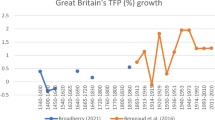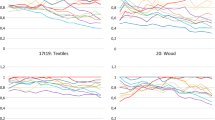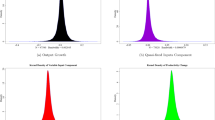Abstract
This paper explores the causes of inter-temporal variations in factor intensities and total factor productivity (TFP) in Canadian industries. For this purpose, we estimated translog cost function at the sector level allowing for non-homotheticity and non-neutral technical progress. Our empirical results suggest that about 15 to 20 per cent of the post-1973 slowdown in TFP is due to the inter-industry shifts in factor inputs. The remaining productivity slowdown could be attributed to the world wide slowdown in aggregate demand (lower capacity utilization rates) and the substantial increase in the relative price of energy and raw materials.
Similar content being viewed by others
References
Berndt, E.R., andD.O. Wood: Engineering and Econometric Interpretations of Energy — Capital Complemenarity. American Economic Review, 1979.
-: Engineering and Economic Interpretations of Energy — Capital Complementarity. Reply and Further Results. American Economic Review, 1981.
—: The Technology, Prices, and the Derived Demand for Energy. Review of Economics and Statistics57, 1975, 259–268.
Berndt, E.R., M.A. Fuss, andL. Waverman: A Dynamic Model of Costs of Adjustments and Inter-related Factor Demands, with an Empirical Application to Energy Demand in U.S. Manufacturing. EPRI, Final Report, 1979.
Berndt, E.R., andG.C. Watkins: Energy Prices and Productivity Trends in Canadian Manufacturing Sector, 1957–76: Some Exploratory Results. Economic Council of Canada, 1982.
Binswanger, H.P.: The Measurement of Technical Change Biases with Many Factors of Production. American Economic Review, 1974, 964–976.
Blain, L.: Recent Developments in Aggregate Labour Productivity. Bank of Canada Review, 1977, 3–15.
Bruno, M.: World Shocks, Macroeconomic Response and the Productivity Puzzle. NBER Working Paper No. 942, 1982.
Burgess, D.F.: Duality Theory and Pitfalls in the Specification of Technologies. Journal of Econometrics 3, 1975.
Carmicheal, E.A.: Reassessing Canada's Potential Economic Growth. The Conference Board of Canada, 1979.
Howe, C.D. Research Institute: Policy Review and Outlook, 1979. Anticipating the Unexpected. Research Institute, 1980.
Christensen, L.R., D. Jorgenson, andL. Lau: Transcendental Logarithmic Production Frontiers. Review of Economics and Statistics55, 1973, 28–45.
Conrad, K., andD. Jorgenson: Tests of a Model of Pfoduction for the Federal Republic of Germany 1950–1973. European Economic Review, 1977, 51–75.
Daly, DJ.: Remedies for Increasing Productivity Levels in Canada. Lagging Productivity Growth: Causes and Remedies, 1980.
Diewert, W.E.: An Application of the Shephard Duality Theorem: A Generalized Leonties Production Function. Journal of Political Economy79, 1971, 481–507.
Economic Council of Canada: A Climate of Uncertainty: Seventeenth Annual Review. ECC, 1980.
Fuss, M.A.: The Demand for Energy in Canadian Manufacturing. Journal of Econometrics5, 1977.
Fuss, M.A., andL. Waverman: The Demand for Energy in Canada. Working Paper, Institute for Policy Analysis, University of Toronto, 1975.
Griffin, J:M.: Joint Production Technology: The Case of Petrochemicals. Econometrica, Vol. 46, No. 2, 1978.
-: The Effects of Higher Prices on Electricity Consumption. The Bell Journal of Economics and Management Science, 1974.
Griffin, J.M., andP.R. Gregory: An Intercountry Translog Model of Energy Substitution Responses. American Economic Review, 1976, p. 66.
-: Engineering and Econometric Interpretations of Energy — Capital, Complimentarity: Comment, American Economic Review, 1981.
Hudson, E.A., andD.W. Jorgenson: U.S. Energy Policy and Economic Growth, 1975–2000. The Bell Journal of Economics and Management Science, 1974.
Hulten, C.R.: Growth Accounting with Intermediate Inputs. Review of Economic Studies, 1978.
Humphrey, D.B., andA. Toeves: Factor Use: An Analysis of Labour Capital and Natural Resource Inputs. Southern Economic Journal44 (2), 1977, 222–239.
Humphrey, D.V., andJ.R. Morley: Substitution among Capital, Labour, and Natural Resource Products in American Manufacturing. Journal of Political Economy 83, 1975.
Jarrett, P.J., andJ.G. Selody: The Productivity Inflation Nexus in Canada: 1963–1979. Review of Economics and Statistics, 1982.
Jorgenson, D.W.: Energy Prices and Productivity Growth. Harvard University, Mimeo, 1980.
McRae, R.N.: Regional Demand for Energy by Canadian Manufacturing Industries. Canadian Energy Research Institute, Working Paper 1978, 78-7.
Melvin, J.R.: Intermediate Goods and Technical Change. Economica, 1969.
Mittelstadt, A., andV. Hall: Price and Income Elasticities of Final Energy Demand in OECD Countries. Paper presented to the third annual IAEE Conference on International Energy Issues, University of Toronto, Ontario, 1981.
Nishimizu, M., andC.R. Hulten: The Importance of Productivity Change in the Economic Growth in the Nine Industrialized Countries. Lagging Productivity Growth: Causes and Remedies, (ed. S. Maital and N.M. Meltz), Ballinger Publishing Company, Cambridge Massachusetts, 1980.
Nordhaus, W.D.: The Recent Productivity Slowdown. Brookings Papers on Economic Activity, Vol.3, 1972, 493–545.
Norsworthy, J.R., andM.J. Harper. The Role of Capital Formation in the Recent Slowdown in Productivity Growth. Working Paper 87, U.S. Department of Labour, Bureau of Labour Statistics, 1979.
OECD: Why Do Substitution Elasticities Differ? Discussion Paper for the New York Seminar, 1982.
Ostry, S., and P.S. Rao: Productivity Trends in Canada. Lagging Productivity Growth: Causes and Remedies, 1980.
Parks, R.W.: Price Responsiveness of Factor Utilization in Swedish Manufacturing, 1890–1950. The Review of Economics and Statistics LII2, 1971, 129–139.
Pindyck, R.S.: Interfuel Substitution and the Industrial Demand for Energy: an International Comparison. The Review of Economics and Statistics, 1979.
Rao, P.S.: An Econometric Analysis of Labour Productivity in Canadian Industries. Economic Council of Canada, Discussion Paper No. 125, 1978.
-: An Econometric Analysis of Labour Productivity in Canadian Industries: Some Further Results. Economic Council of Canada, Discussion Paper No.134, 1979.
—: Factor Prices and Labour Productivity in the Canadian Manufacturing Industries. Empirical Economics, Vol.6, 1981, 187–202.
Samuelson, P.A.: Foundations of Economic Analysis. Cambridge, 1947.
Sharpe, A.: A Disaggregated Analysis of the Productivity Slowdown in Canada. A paper presented at the AER Meetings in Washington, DC, 1981.
Shephard. R.W.: Cost and Production Functions. Princeton, 1953.
Star, S.: Accounting for the Growth of Output. American Economic Review, 1974.
Stuber, G.: The Recent Slowdown in the Growth of Productivity: Some Explanations of the Puzzle. Bank of Canada Review, 1981.
-: A Note on Productivity Development at the Industry Level. Bank of Canada Review, 1982.
Sims, H., andJ. Stanton: Recent Changes in Patterns of Productivity Growth in Canada. Department of Finance, Canada, 1980.
Tatom, J.A.: Energy Prices and Capital Formation: 1972–1977. Federal Reserve Bank of St. Louis, 1979.
Uzawa, H.: Production Functions with Constant Elasticities of Substitution. Review of Economic Studies29, 1962, 291–299.
Weinban-Smith, G.C.: Factors Influencing Recent Productivity Growth-Report on a Survey of Companies. National Institute Economic Review, 1982, 57–66.
Zellner, A.M.: An Efficient Method of Estimating Seemingly Unrelated Regressions and Tests for Aggregation Bias. Journal of American Statistical Association57, 1962, 585–612.
Author information
Authors and Affiliations
Rights and permissions
About this article
Cite this article
Rao, P.S., Preston, R.S. Inter-factor Substitution, economies of scale and technical change: Evidence from Canadian industries. Empirical Economics 9, 87–111 (1984). https://doi.org/10.1007/BF01969389
Received:
Issue Date:
DOI: https://doi.org/10.1007/BF01969389




